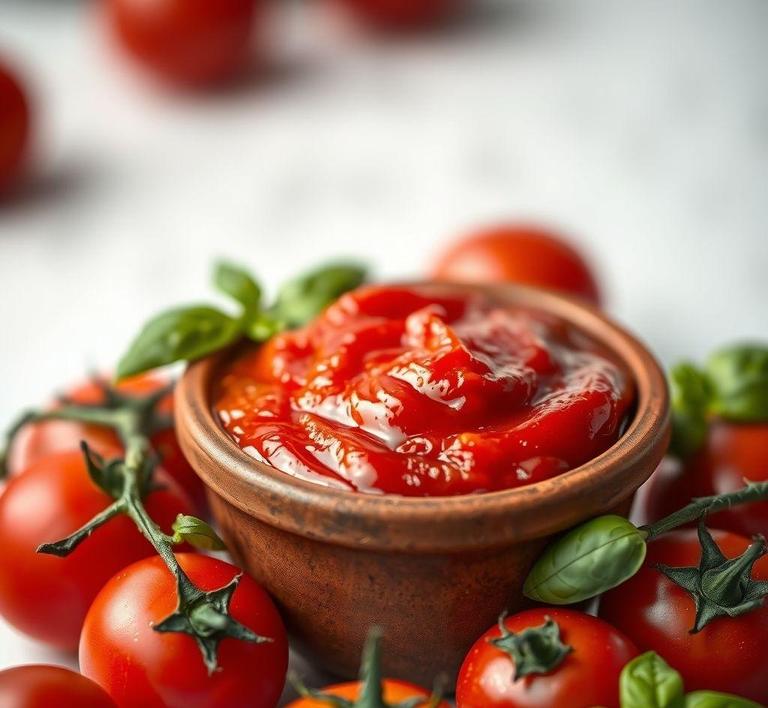If you’ve ever found yourself with leftover tomato paste, you might be wondering if you can refreeze it for later use. The good news is, yes, you can! Refreezing tomato paste is actually a great way to extend its shelf life and reduce food waste. Whether you’re dealing with a large can that you didn’t finish or a homemade batch, knowing how to properly store and refreeze it can save you time and money in the kitchen. In this guide, we’ll walk you through the best methods to refreeze tomato paste, so you can have it on hand whenever you need it, without sacrificing flavor or texture.
Can You Refreeze Tomato Paste?

Tomato paste is a staple ingredient in many kitchens, known for its rich, concentrated flavor that enhances sauces, soups, stews, and even pizza. It’s made by simmering tomatoes to reduce moisture, resulting in a thick, intensely flavorful product. Like other perishable foods, tomato paste can be stored in the fridge or freezer, but what happens if you’ve used a portion of it and are left with some leftovers? Can you refreeze tomato paste?
The short answer is yes, you can refreeze tomato paste-but it comes with some considerations. Freezing, in general, can significantly extend the shelf life of tomato paste, which typically lasts around 5 to 7 days in the refrigerator once opened. But while freezing is an effective method of preservation, the process of refreezing is more complicated. Each freeze-thaw cycle can potentially affect the texture, color, and overall quality of the product.
When you freeze tomato paste, the water in it begins to form ice crystals. This can break down its cellular structure, resulting in a slight loss of its consistency and texture. If you’ve thawed it once and then freeze it again, these ice crystals may form more rapidly and in larger quantities. This is because some of the moisture from the paste is released during the initial thaw, which can make it more prone to crystallization during the second freezing process. While the flavor generally remains intact, the paste may become more watery and less smooth upon thawing a second time.
That said, if you follow the correct procedures for refreezing, you can minimize the negative effects. But first, let’s dive into how to properly refreeze tomato paste.
How To Refreeze Tomato Paste?
To refreeze tomato paste effectively and preserve as much of its quality as possible, it’s essential to follow the proper steps, ensuring that the paste is stored and handled correctly. Here’s a detailed guide on how to do it:
-
Portion the Paste Before Freezing:
The best way to prevent unnecessary thawing and refreezing is to portion out the tomato paste before freezing it initially. This can be done by spooning the paste into ice cube trays, silicone molds, or freezer-safe bags. By freezing it in small portions, you can easily grab just the amount you need, leaving the rest untouched.
-
Properly Thaw Tomato Paste:
If you’ve already frozen a portion of tomato paste and need to refreeze it, make sure to thaw it slowly. The best method is to transfer the frozen paste to the refrigerator and let it defrost overnight. Rapid thawing at room temperature or in the microwave may cause more moisture to be released, which can lead to texture loss and a watery consistency once it’s refrozen.
-
Check for Contamination:
Make sure that the tomato paste hasn’t been exposed to contaminants during its thawing process. If there is any sign of mold, an off smell, or discoloration, discard it. Even small amounts of bacteria can grow when food is thawed and refrozen, so it’s better to be cautious.
-
Use Airtight Containers:
When it comes to refreezing, airtight containers are your best friend. Freezer bags or jars should be sealed tightly to avoid freezer burn, which can dry out the paste and affect its texture. If you’re using freezer bags, make sure to remove as much air as possible to maintain the best quality.
-
Freeze in Smaller Amounts:
Just as you did with the initial freezing, divide the paste into portions that you’ll use in a single sitting. This way, you avoid thawing the entire batch and refreezing what you don’t use, thus minimizing repeated freezing cycles.
-
Label and Date:
Don’t forget to label the containers with the date. Freezing food for long periods can result in a degradation of quality, even if it’s still safe to eat. Keeping track of when you froze the paste will help you monitor how long it’s been in the freezer and use it while it’s at its best.
Quality Impact
The quality of tomato paste after it’s been thawed and refrozen is a significant consideration. Freezing changes the structure of many foods, especially those with high moisture content like tomato paste. While freezing doesn’t make it unsafe to eat, the texture and consistency will often suffer.
Texture Loss: The most noticeable change when you refreeze tomato paste is its texture. Tomato paste is a thick, smooth concentrate, but when frozen and thawed, the structure of the paste can break down, leaving it more watery or grainy. The initial freezing causes the water content in the paste to crystallize, and when it thaws, the paste becomes separated or thinner. When refrozen, the texture is likely to degrade even more, becoming even less smooth and more prone to separation.
Flavor: One of the upsides to freezing tomato paste is that its flavor typically remains intact. The deep, rich taste of tomato paste is relatively stable in freezing conditions. However, while refreezing won’t diminish the flavor significantly, the slight change in texture might affect how it blends with your dishes. For example, if you’re adding it to a soup or sauce, you may notice that it doesn’t mix as seamlessly as it did when fresh.
Color Changes: Tomato paste can also change color after being frozen and thawed, taking on a slightly darker or more brownish hue. This is due to the breakdown of some of its natural sugars and acids during the freezing process. While this doesn’t affect the taste, it can alter the visual appeal of the paste, particularly when used as a topping or a main ingredient in certain dishes.
Nutritional Value: Nutritionally, freezing and refreezing tomato paste won’t result in significant losses of vitamins or minerals. Tomato paste is a concentrated source of antioxidants, particularly lycopene, and these nutrients are relatively stable through freezing. However, the overall nutrient content may decrease slightly over extended periods of freezing, especially if there’s significant exposure to air or if it’s stored improperly.
So, can you refreeze tomato paste? Yes, but with caution. The texture and appearance of the paste will likely be affected, and while its flavor will generally remain intact, it may not blend as smoothly into your dishes. To minimize quality loss, it’s best to portion the paste before freezing it and to follow proper thawing and refreezing techniques. Always be mindful of the fact that the more you freeze and thaw, the greater the likelihood of a noticeable degradation in the paste’s consistency.
In short, if you plan to refreeze tomato paste, do so thoughtfully. Proper portioning, airtight sealing, and careful handling can ensure that your tomato paste remains usable for future cooking without compromising too much on its quality. With a little extra care, you can continue to enjoy the rich flavor of tomato paste even after it’s been frozen and refrozen.
Is It Safe To Refreeze Tomato Paste?
Refreezing tomato paste can seem like an easy way to avoid food waste, especially since this ingredient often comes in large cans or tubes, and you might not use the entire amount at once. But is it safe? The short answer is yes, it is generally safe to refreeze tomato paste, as long as you do it correctly. However, it’s essential to consider both the safety and quality aspects before deciding to refreeze it.
Tomato paste is a concentrated product, which means it’s rich in flavor and texture. When you freeze it initially, the paste solidifies, preserving its nutritional value, flavor, and consistency. Refreezing won’t cause any significant harm to the paste as long as the process is done under the right conditions. The biggest concern, however, lies in the degradation of its texture and flavor, as freezing and thawing repeatedly can affect the integrity of the product.
Key Considerations
- Quality Over Time: Each freeze-thaw cycle reduces the flavor intensity and can cause the paste to become slightly grainy, making it less desirable in dishes where a smooth texture is essential.
- Freezer Burn: One of the most common risks of refreezing is freezer burn, which happens when air is trapped in the packaging, causing dehydration of the paste and a loss of flavor. To minimize this, store the tomato paste in an airtight container or wrap it securely in plastic wrap before freezing.
Signs That Tomato Paste Should Not Be Refrozen
While it’s often safe to refreeze tomato paste, there are certain signs to look for that indicate your paste should not be refrozen. These signs point to spoilage or improper handling, making the refreezing process potentially unsafe or ineffective.
- Off Smell or Mold Growth: If the tomato paste has developed an unpleasant odor or visible mold, it should not be refrozen. The presence of mold is a clear indication that bacteria have started to proliferate, and refreezing would not stop this process. Additionally, spoiled paste may emit a sour or fermented smell.
- Change in Color: Fresh tomato paste is a vibrant red, but if it starts to turn a dull brownish or grayish hue, this could be a sign of oxidation, which affects both its taste and safety. Once the paste starts to discolor, it should be discarded rather than refrozen.
- Separation or Watery Texture: If the paste has separated into liquid and solid components after thawing, it’s a sign that the freezing process has altered its composition. While this doesn’t necessarily mean it’s unsafe, it can affect the quality. If the texture is excessively watery or slimy, it’s best to toss the paste instead of refreezing.
- Extended Time in the Freezer: If the tomato paste has been in the freezer for months, even if it still appears to be in good condition, it might have lost much of its flavor and texture. While the paste may not necessarily be unsafe, it may not be worth refreezing due to a significant decline in quality.
Common Refreezing Mistakes
While it’s not inherently dangerous to refreeze tomato paste, certain mistakes can compromise both its safety and quality. Here are some common errors people make when freezing and refreezing this ingredient:
- Incorrect Storage After Initial Freezing: One of the most common mistakes is improperly storing tomato paste after the initial freeze. If the paste is not sealed tightly or stored in an airtight container, it can develop freezer burn. Always ensure the paste is in a well-sealed container or wrapped properly to keep air and moisture out.
- Freezing in Large Quantities: Many people make the mistake of freezing an entire can or tube of tomato paste at once. While this may be convenient, it makes thawing and refreezing difficult, as you’ll have to thaw the entire batch instead of taking out small portions. It’s better to portion out the tomato paste into smaller amounts, either in ice cube trays or small containers, before freezing.
- Thawing Incorrectly: Thawing tomato paste improperly is another mistake that can lead to texture changes and loss of flavor. Never thaw tomato paste on the counter at room temperature, as this could lead to bacterial growth. Instead, thaw it in the refrigerator or use it directly from the freezer in cooked dishes.
- Refreezing Multiple Times: Each freeze-thaw cycle reduces the quality of the tomato paste. Refreezing multiple times can lead to mushiness, loss of flavor, and a dull, unappealing texture. Limit the number of times you freeze and thaw the paste to maintain the best possible quality.
Tips And Tricks
To ensure that your tomato paste stays as fresh and flavorful as possible through the freezing and refreezing process, here are a few helpful tips and tricks:
- Portion It Out Before Freezing: If you don’t plan to use the entire can or tube of tomato paste, portion it out into smaller quantities. You can use ice cube trays, silicone molds, or small containers to freeze the paste in easily usable portions. This way, you won’t have to thaw the entire batch and risk waste.
- Use Plastic Wrap for Extra Protection: For added protection, especially if you’re freezing the paste directly from the can, wrap it in plastic wrap before placing it in a freezer bag or airtight container. This provides an additional layer of protection against freezer burn and preserves the flavor.
- Label and Date Your Paste: Label the container with the date of freezing to keep track of how long it has been in the freezer. Tomato paste can last for about 3 to 6 months in the freezer, but the sooner you use it, the better the quality will be.
- Consider Using Tomato Paste Cubes: If you freeze small portions of tomato paste in ice cube trays, you can pop out individual cubes as needed. This method makes it easy to add exactly the amount you need to dishes like soups, stews, and sauces without defrosting an entire batch.
- Avoid Over-Thawing: Thaw only what you need. When thawing, don’t let the paste sit out for too long, and avoid refreezing any portion that has already been thawed. Refreezing previously thawed tomato paste can affect its taste and texture significantly.
Conclusion
Refreezing tomato paste is certainly possible, but it requires careful attention to storage methods, timing, and handling to ensure both safety and quality. As long as you’re vigilant about keeping the paste properly sealed, using small portions, and not over-thawing, you can safely extend the life of your tomato paste with minimal loss of flavor and texture.
Keep an eye out for signs of spoilage such as unusual odor, discoloration, or watery separation, and avoid common mistakes like refreezing multiple times or thawing improperly. By following some simple tips, you can make the most out of your tomato paste, reducing waste and making your kitchen more efficient.


